Dell XPS Gaming Desktop Computer 8950 | Setup & Specs
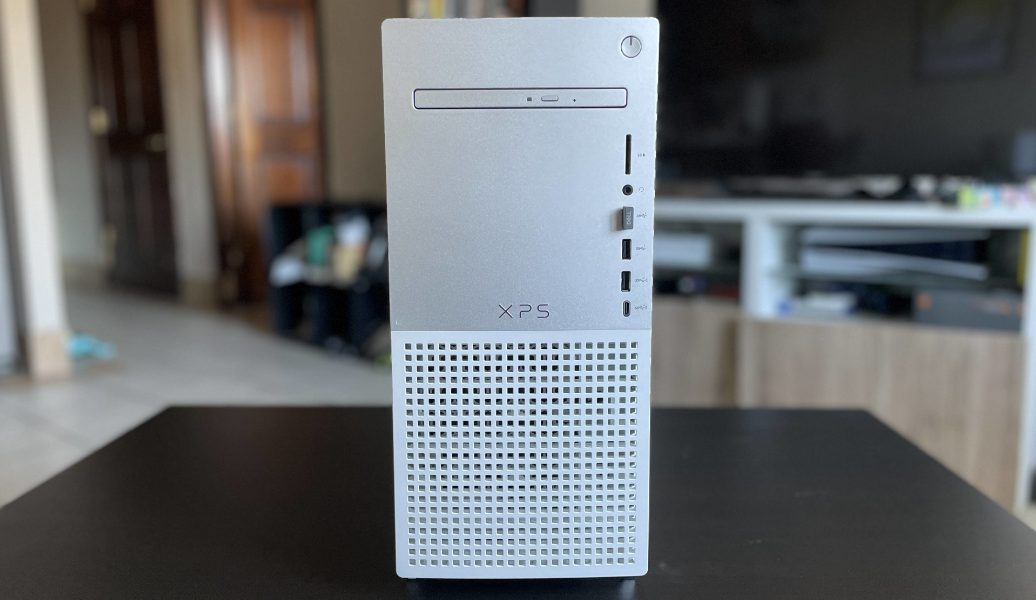
Content

Introduction of Dell XPS Gaming Desktop Computer 8950
The Dell XPS Gaming Desktop Computer is a high-performance machine designed for serious gamers and creative professionals. With a sleek and compact design, this desktop computer packs a powerful punch, featuring the latest Intel Core i9 processors, NVIDIA GeForce RTX 3080 graphics, and up to 128GB of DDR4 memory. The estimated price for this desktop computer is around $3,000 to $4,000, depending on the specific configurations. The Dell XPS Gaming Desktop Computer 8950 was launched in October 2021.
Detailed Specifications
The Dell XPS Gaming Desktop Computer 8950 features the latest Intel Core i9-11900K processor, up to 128GB of DDR4 RAM, and up to 4TB of NVMe SSD storage. The graphics card is the NVIDIA GeForce RTX , which offers excellent performance and support for real-time ray tracing and AI technologies. The desktop computer also features a liquid cooling system, which helps keep the system running cool and quiet, even under heavy loads. Other notable specifications include Wi-Fi 6 and Bluetooth 5.2 connectivity, multiple USB and DisplayPort ports, and support for up to three 4K monitors.
Dimensions and weight
The following table lists the height, width, depth, and weight of your XPS 8950.
| Description | Values |
| Height |
|
| Width | 173 mm (6.81 in.) |
| Depth | 426.70 mm (16.80 in.) |
Weight
|
|
Processor
The following table lists the details of the processors that are supported by your XPS 8950.
Processor type | Processor wattage | Processor core count | Processor thread count | Processor speed | Processor cache | Integrated graphics |
12th Generation Intel Core i3-12100 | 65 W | 4 | 8 | Up to 4.30 GHz | 12 MB | Intel UHD Graphics |
12th Generation Intel Core i5-12400 | 65 W | 6 | 12 | Up to 4.40 GHz | 18 MB | Intel UHD Graphics |
12th Generation Intel Core i5-12600K | 125 W | 10 | 16 | Up to 4.90 GHz | 20 MB | Intel UHD Graphics |
12th Generation Intel Core i7-12700 | 65 W | 12 | 20 | Up to 4.90 GHz | 25 MB | Intel UHD Graphics |
12th Generation Intel Core i7-12700F | 65 W | 12 | 20 | Up to 4.90 GHz | 25 MB | None |
12th Generation Intel Core i7-12700K | 125 W | 12 | 20 | Up to 5 GHz | 25 MB | Intel UHD Graphics |
12th Generation Intel Core i7-12700KF | 125 W | 12 | 20 | Up to 5 GHz | 25 MB | None |
Processor type | Processor wattage | Processor core count | Processor thread count | Processor speed | Processor cache | Integrated graphics |
12th Generation Intel Core i9-12900 | 65 W | 16 | 24 | Up to 5.10 GHz | 30 MB | Intel UHD Graphics |
12th Generation Intel Core i9-12900K | 125 W | 16 | 24 | Up to 5.20 GHz | 30 MB | Intel UHD Graphics |
12th Generation Intel Core i9-12900KF | 125 W | 16 | 24 | Up to 5.20 GHz | 30 MB | None |
Chipset
The following table lists the details of the chipset supported by your XPS 8950.
| Description | Values |
| Chipset | Z690 |
| Processor |
|
| DRAM bus width | 128-bit |
| Flash EPROM | 32 MB |
| PCIe bus | Up to Gen4.0 |
Views of Dell 8950
Front
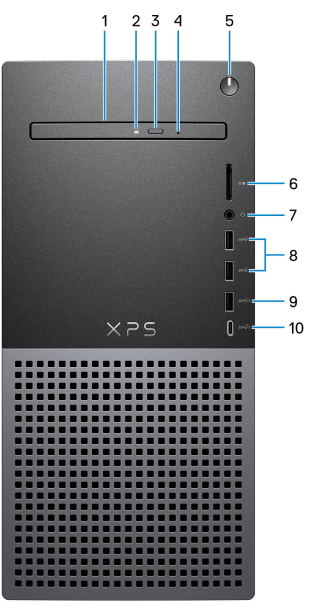
- Slim optical drive (optional)
The optical drive reads from and writes to CDs and DVDs. - Optical-drive activity light
The optical-drive activity light turns on when the computer reads from or writes to an optical drive. - Optical-drive eject button
Press to open the optical drive tray. - Optical-drive emergency eject pinhole
Used to eject the optical-drive tray manually if the optical-drive eject button fails. - Power button
- Press to turn on the computer if it is turned off, in sleep state, or in hibernate state.
- Press to put the computer in sleep state if it is turned on.
- Press and hold to force shut-down the computer.
- SD-card slot
Reads from and writes to the SD card. The computer supports the following card types:- Secure Digital (SD)
- Secure Digital High Capacity (SDHC)
- Secure Digital Extended Capacity (SDXC)
- Universal Audio Jack
Connect headphones or a headset (headphone and microphone combo). - USB 3.2 Gen 1 ports (2)
Connect devices such as external storage devices and printers. Provides data transfer speeds up to 5 Gbps. - USB 3.2 Gen 1 port with PowerShare
- Connect devices such as external storage devices and printers.
- Provides data transfer speeds up to 5 Gbps. PowerShare enables you to charge connected USB devices.
- USB 3.2 Gen 2 Type-C port with PowerShare
- Connect devices such as external storage devices and printers.
- Provides data transfer speeds up to 10 Gbps. Provides up to 15 W power output that enables faster charging.
NOTE: Deep Sleep is enabled by default. Disable Deep Sleep in the BIOS to enable PowerShare feature on your computer.
NOTE: PowerShare enables you to charge your USB devices even when your computer is turned off.
Back
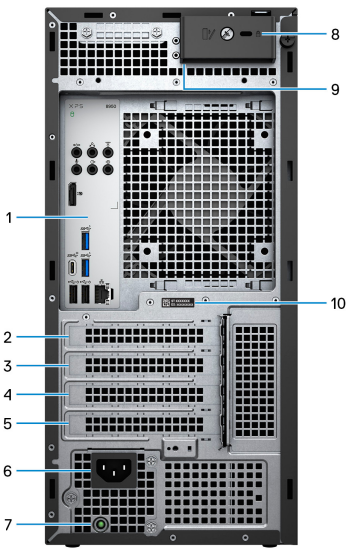
- Back panel
Connect USB, audio, video, and other devices. - PCI-express x4 slot
Connect a PCI-express card such as an audio or network card to enhance the capabilities of your computer. - PCI-express X16 slot
Connect a PCI-express graphics card to enhance the capabilities of your computer. - Expansion slot for dual-width graphics card
This expansion slot seats the bottom half of a dual-width graphics card if it is installed in the PCI-Express x16 slot. - PCI-express x4 slot
Connect a PCI-express card such as an audio or network card to enhance the capabilities of your computer. - Power port
Connect a power cable to provide power to your computer. - Power-supply diagnostics light
Indicates the power-supply state. - Security-cable slot (wedge-shaped)
Connect a security cable to prevent unauthorized movement of your computer. - Padlock rings
Attach a standard padlock to prevent unauthorized access to the interior of your computer. - Service Tag label
The Service Tag is a unique alphanumeric identifier that enables Dell service technicians to identify the hardware components in your computer and access warranty information.
Back panel
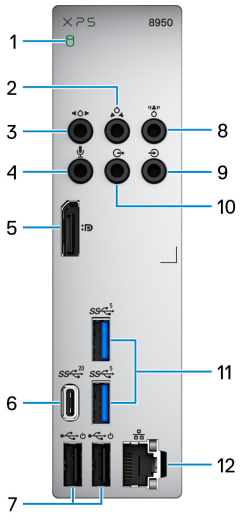
- Hard-drive activity light
The activity light turns on when the computer reads from or writes to the hard drive. - Rear L/R surround port
Connect audio-output devices such as speakers and amplifiers. In a 5.1 or 7.1 speaker channel setup, connect the rear-left and rear-right speakers. - Side L/R surround port
Connect audio-output devices such as speakers and amplifiers. In a 7.1 speaker channel setup, connect the side-left and side-right speakers. - Microphone port
Connect an external microphone to provide sound input. - Dual-Mode DisplayPort 1.4
Connect an external display or a projector. - USB 3.2 Gen 2x2 Type C port
Connect devices such as external storage devices and printers. Provides data transfer rate of up to 20 Gbps.
NOTE: This port does not support video/audio streaming. 7. USB 2.0 ports with Smart Power On (2) - Center or subwoofer surround port
Connect the center speaker and/or subwoofer. - Line-in port
Connect recording or playback devices such as a microphone or CD player. - Front L/R surround line-out port
Connect audio-output devices such as speakers and amplifiers. In a 2.1 speaker channel setup, connect the left and right speakers. In a 5.1 or a 7.1 speaker channel setup, connect the front-left and front-right speakers. - USB 3.2 Gen 1 ports (2)
Connect devices such as external storage devices and printers. Provides data transfer speeds up to 5 Gbps. - Network port (with lights)
Connect an Ethernet (RJ45) cable from a router or a broadband modem for network or Internet access.
The two lights next to the connector indicate the connectivity status and network activity
Setup of XPS Gaming Desktop Computer
Setting up the Dell XPS Gaming Desktop Computer 8950 is a straightforward process. Simply unpack the desktop computer, connect the power cord and any necessary peripherals, and turn it on. The desktop computer will automatically detect any connected monitors and configure the display settings accordingly. To install any additional software or drivers, simply visit the Dell website and download the necessary files. It's also a good idea to install any available firmware updates to ensure that the system is running at optimal performance.
NOTE: The images in this document may differ from your computer depending on the configuration you ordered.
Connect the keyboard and mouse to the USB ports on the computer. If you have a wireless keyboard and mouse, see the documentation that shipped with the wireless keyboard and mouse for instructions.

Connect to your network using an Ethernet cable. Alternatively, connect to an available wireless network when setting up the operating system.

Connect the display. For more information about setting up the display, see the documentation that is shipped with your display.
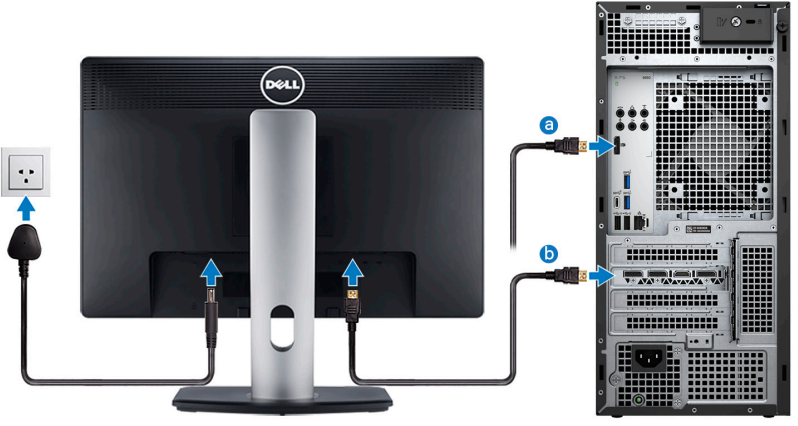
NOTE: There are different connection points for your display depending on whether your computer has a discrete graphics card installed.- Connect the display cable to this DisplayPort connector if your computer does not have a discrete graphics card installed.
- Connect the display cable to any of these connectors if your computer has a discrete graphics card installed.
Connect the power cable to the computer and then connect it to the wall outlet.
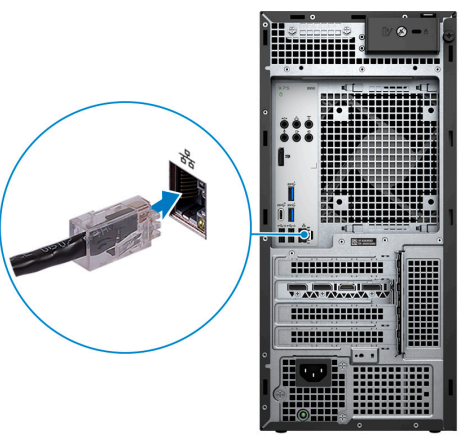
Press the power button at the front of the computer to turn it on. If required, press the power button on the display to turn it on.
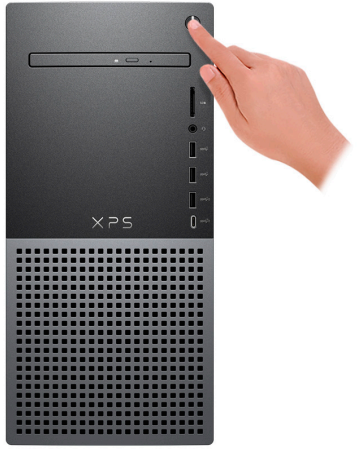
- Finish Windows setup.
Follow the on-screen instructions to complete the setup. When setting up, Dell recommends that you:- Connect to a network for Windows updates.
NOTE: If connecting to a secured wireless network, enter the password for the wireless network access when prompted. - If connected to the Internet, sign in with or create a Microsoft account. If not connected to the Internet, create an offline account.
- On the Support and Protection screen, enter your contact details.
- Connect to a network for Windows updates.
- Locate and use Dell apps from the Windows Start menu Recommended.
Locate Dell apps
| Resources | Description |
My Dell | My Dell Centralized location for key Dell applications, help articles, and other important information about your computer. It also notifies you about the warranty status, recommended accessories, and software updates if available. |
SupportAssist
| SupportAssist SupportAssist proactively and predictively identifies hardware and software issues on your computer and automates the engagement process with Dell Technical support. It addresses performance and stabilization issues, prevents security threats, monitors, and detects hardware failures. For more information Click SupportAssist and then, click SupportAssist for Home PCs. NOTE: In SupportAssist, click the warranty expiry date to renew or upgrade your warranty. |
Dell Update | Dell Update Updates your computer with critical fixes and the latest device drivers as they become available. For more information about using Dell Update, |
Dell Digital Delivery
| Dell Digital Delivery Download software applications, which are purchased but not preinstalled on your computer. For more information about using Dell Digital Delivery, |
Description
The Gaming Desktop Computer 8950 is a powerful and versatile desktop computer that is ideal for gaming, video editing, 3D rendering, and other demanding applications. The compact design makes it easy to fit into any workspace, while the sleek and modern look adds a touch of style to any setup. With support for up to three 4K monitors, this desktop computer offers an immersive and engaging experience, whether you're playing games, editing videos, or working on complex 3D models. The liquid cooling system ensures that the system runs quietly and efficiently, even under heavy loads, while the Wi-Fi 6 and Bluetooth 5.2 connectivity provide fast and reliable wireless connectivity.
Operating system
Your XPS 8950 supports the following operating systems
- Windows 11 Home, 64-bit
- Windows 11 Pro, 64-bit
- Windows 11 Home Advanced, 64-bit
- Windows 11 Pro Advanced, 64-bit
Memory
The following table lists the memory specifications of your XPS 8950.
| Description | Values |
| Memory slots | Four UDIMM slots |
| Memory type | Dual-Channel DDR5 |
| Memory speed | 3600 MHz, 4000 MHz, 4400 MHz |
| Description | Values |
| Maximum memory configuration | 128 GB |
| Minimum memory configuration | 8 GB |
| Memory size per slot | 8 GB, 16 GB, 32 GB |
| Memory configurations supported |
|
Ports and connectors
The following table lists the external and internal ports available on your XPS 8950.
| Description | Values |
| External: | |
| Network | One RJ-45 port |
| USB |
|
| Audio |
|
| Video | One Dual-Mode DisplayPort 1.4 |
| Media-card reader | One SD-card slot |
| Power port | One AC power-supply port |
| Security |
|
| Internal: | |
| PCIe expansion card slots |
|
| mSATA | Not supported |
| SATA |
|
| M.2 |
|
| Description | Values |
|
|
Ethernet
The following table lists the wired Ethernet Local Area Network (LAN) specifications of your XPS 8950
| Description | Values |
| Model number | Killer E3100G Ethernet controller |
| Transfer rate | 10/100/1000/2500 Mbps |
Wireless module
The following table lists the Wireless Local Area Network (WLAN) module specifications of your XPS 8950.
| Description | Values |
| Model number | Killer 1675x |
| Transfer rate | Up to 2400 Mbps |
| Frequency bands supported | 2.4 GHz/5 GHz |
| Wireless standards |
|
| Encryption |
|
| Bluetooth | Bluetooth 5.2 |
Storage
This section lists the storage options on your XPS 8950.
Your XPS 8950 supports one of the following storage configurations
- Up to two 3.5-inch hard drives, or
- Up to two 3.5-inch hard drives + up to two M.2 2230/2280 solid-state drives.
The primary drive of your XPS 8950 varies with the storage configuration. For computers - with a M.2 drive, the M.2 drive where your operating system is installed is the primary drive.
- without a M.2 drive, the 3.5-inch hard drive where your operating system is installed is the primary drive.
NOTE: The storage capacity of each 3.5-inch, M.2 2230 or 2280 solid-state drive is dependent on the configuration ordered. The following section lists the possible storage options for your computer from Dell.com. Depending on your region, some options may not be available.
| Storage type | Interface type | Capacity |
| 3.5-inch hard drive | SATA AHCI, up to 6 Gbps | Up to 2 TB |
| M.2 2230 solid-state drive | PCIe Gen3.0x4 NVMe, up to 32 Gbps | Up to 256 GB |
| M.2 2230 solid-state drive | PCIe Gen4.0x4 NVMe, up to 64 Gbps | Up to 256 GB |
| M.2 2280 solid-state drive | PCIe Gen4.0x4 NVMe, up to 64 Gbps | Up to 2 TB |
| 9.5 mm 16x Slimline DVD-RW drive | SATA AHCI, up to 1.5 Gbps | One DVD-RW |
GPU—Integrated
The following table lists the specifications of the integrated Graphics Processing Unit (GPU) supported by your XPS 8950.
| Controller | External display support | Memory size | Processor |
| Intel UHD Graphics | One Dual-Mode DisplayPort 1.4 | Shared-system memory |
|
GPU—Discrete
The following table lists the specifications of the discrete Graphics Processing Unit (GPU) supported by your XPS 8950.
| Controller | External display support | Memory size | Memory type |
| NVIDIA GeForce GTX 1650 SUPER |
| 4 GB | GDDR6 |
| NVIDIA GeForce GTX 1660 SUPER |
| 6 GB | GDDR6 |
| NVIDIA GeForce GTX 1660 Ti |
| 6 GB | GDDR6 |
| NVIDIA GeForce RTX 3060 |
| 12 GB | GDDR6 |
| NVIDIA GeForce RTX 3060 Ti |
| 8 GB | GDDR6 |
| Controller | External display support | Memory size | Memory type |
| NVIDIA GeForce RTX 3070 |
| 8 GB | GDDR6 |
| NVIDIA GeForce RTX 3070 Ti |
| 8 GB | GDDR6X |
| NVIDIA GeForce RTX 3080 |
| 10 GB | GDDR6X |
| NVIDIA GeForce RTX 3080 Ti |
| 12 GB | GDDR6X |
| NVIDIA GeForce RTX 3090 |
| 24 GB | GDDR6X |
| AMD Radeon RX 5300 |
| 3 GB | GDDR6 |
| AMD Radeon RX 6600 XT |
| 8 GB | GDDR6 |
| AMD Radeon RX 6700 XT |
| 12 GB | GDDR6 |
| AMD Radeon RX 6800 XT |
| 16 GB | GDDR6 |
| AMD Radeon RX 6900 XT |
| 16 GB | GDDR6 |
Audio
The following table lists the audio specifications of your XPS 8950.
| Description | Values |
| Audio controller | Realtek ALC3861 with Waves MaxxAudio Pro |
| Internal audio interface | High definition audio interface |
| External audio interface |
|
Power ratings
The following table lists the power-rating specifications of XPS 8950.
| Description | Option one | Option two |
| Type | 460 W Bronze | 750 W Platinum |
| Input voltage | 90 VAC-264 VAC | 90 VAC-264 VAC |
| Input frequency | 47 Hz-63 Hz | 47 Hz-63 Hz |
| Description | Option one | Option two |
| Type | 460 W Bronze | 750 W Platinum |
| Input voltage | 90 VAC-264 VAC | 90 VAC-264 VAC |
| Input frequency | 47 Hz-63 Hz | 47 Hz-63 Hz |
| Description | Option one | Option two | |
| Input current (maximum) | 7 A | 10 A | |
| Output current (continuous) | Operating: | Operating: | |
|
|
| |
|
|
| |
|
|
| |
| Standby: | Standby: | |
|
|
| |
|
|
| |
|
|
| |
| Rated output voltage |
|
| |
| Temperature range: |
|
| |
| Operating | 5°C to 45°C (41°F to 113°F) | 5°C to 45°C (41°F to 113°F) |
| Storage | -40°C to 70°C (-40°Fto 158°F) | -40°C to 70°C (-40°Fto 158°F) |
Getting help and contacting Dell
Self-help resources
You can get information and help on Dell products and services using these self-help resources
| Self-help resources | Resource location |
| Information about Dell products and services | https://www.dell.com/en-pk?auto_show_edge_shopping_pane=1&source=EMS&exp=e99&form=MG0AU0
|
| My Dell app |
|
| |
| Contact Support | In Windows search, type Contact Support, and press Enter. |
| Online help for operating system | |
Access top solutions, diagnostics, drivers and downloads, and learn more about your computer through videos, manuals and documents. | Your Dell computer is uniquely identified by a Service Tag or Express Service Code.
|
| Dell knowledge base articles for a variety of computer concerns |
Support > Knowledge Base.
|
Troubleshooting
If you encounter any issues with the Dell XPS Gaming Desktop Computer 8950, there are a few common solutions to try. First, make sure that the system is properly connected to a power source and that all peripherals are securely attached. If the system is not starting up, try resetting the BIOS by pressing the F2 key during startup. If the system is freezing or crashing, try updating the BIOS or any installed drivers. If you're experiencing issues with the graphics card, try adjusting the display settings or rolling back the driver to a previous version. Finally, if you're still having issues, contact Dell support for further assistance.
Pros & Cons
Pros
- Powerful and versatile performance
- Sleek and modern design
- Quiet and efficient liquid cooling system
- Support for up to three 4K monitors
- Excellent Wi-Fi 6 and Bluetooth 5.2 connectivity
Cons
- Expensive, with a starting price of around $3,000
- May be overkill for casual gamers or basic productivity tasks
- Can be loud under heavy loads, such as gaming or video editing
Customer Reviews of Dell XPS Gaming Desktop Computer 8950
Customers who have purchased the Dell XPS Gaming Desktop Computer have praised its powerful performance, sleek design, and versatility. Many have noted that the liquid cooling system is especially effective, keeping the system running quietly and efficiently even during long gaming sessions. However, some have criticized the high price point, noting that it may be too expensive for casual gamers or those who only need a desktop computer for basic productivity tasks. Overall, the Gaming Desktop Computer 8950 is a top-performing and highly-rated desktop computer that is well-suited for serious gamers and creative professionals.
Faqs
For the first time, how should I configure my Dell XPS Gaming Desktop 8950?
If my Dell XPS Gaming Desktop 8950 won't start up, who should I call?
Is it possible to replace the parts in my Dell XPS Gaming Desktop 8950?
What actions should I take if my Dell XPS Gaming Desktop 8950 is overheating?
How can I keep my Dell XPS Gaming Desktop 8950 operating at peak performance?
In what ways should I use the Dell XPS Gaming Desktop 8950 safely?
How can I fix a Dell XPS Gaming Desktop 8950's software problems?
Which procedures work best to protect the data on my Dell XPS Gaming Desktop 8950?
How should I proceed if my Dell XPS Gaming Desktop 8950 is making strange noises?
With the XPS Gaming Desktop 8950, what kind of warranty does Dell provide?
Leave a Comment
